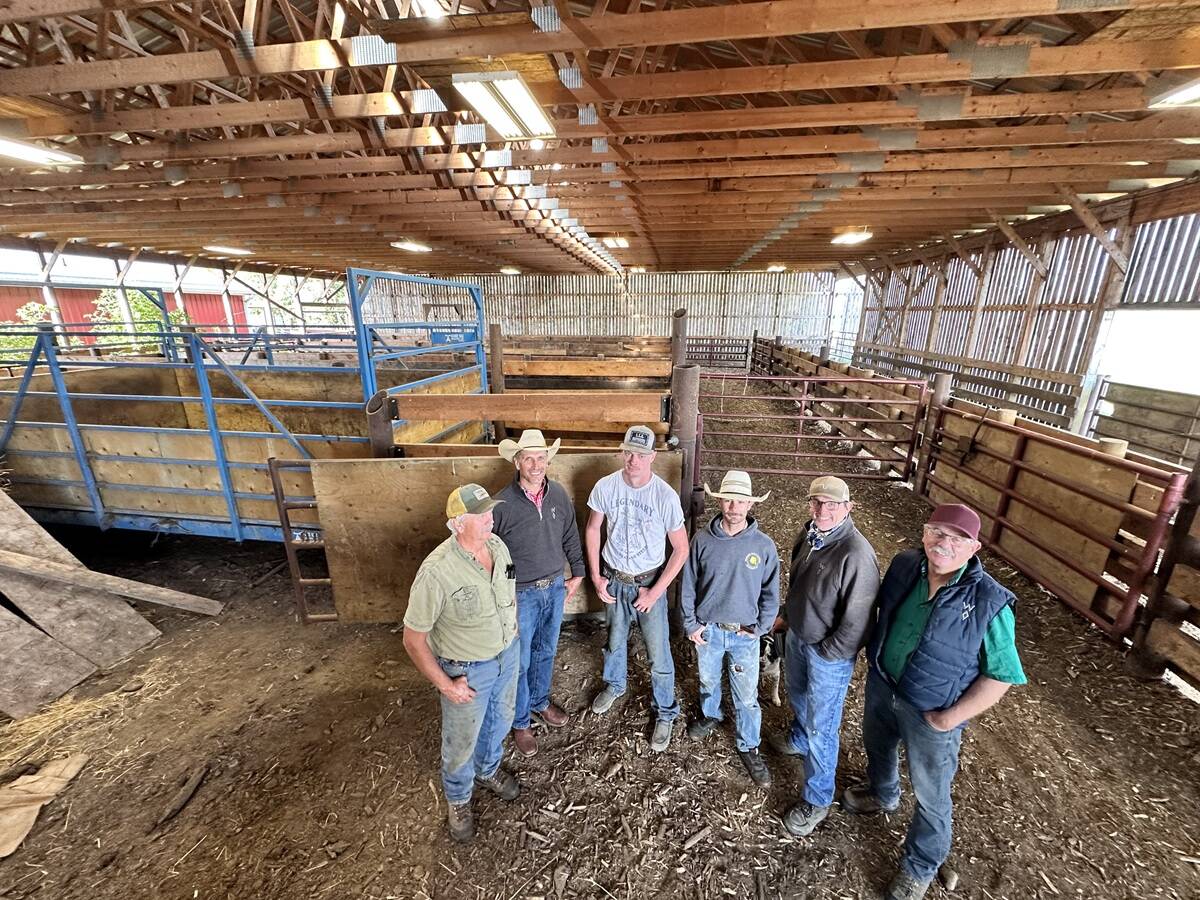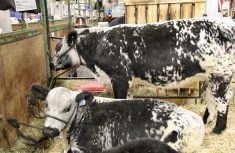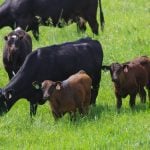When you aim to produce the “best beef in a better world,” you’ve got a lot on your plate. But Sean McGrath tackles the target bite by bite.
Values at the root of the Canadian Roundtable for Sustainable Beef have long been a part of the McGrath family’s fabric as ranchers. It’s kept them viable for five generations in a landscape where there’s very little margin for error.
The ranch is near Vermilion, at the tip of Palliser’s triangle known as the prairie-parkland transition zone. The native fescue rangelands mingle with stands of poplar in a rolling landscape where moisture can often be scarce, or overwhelming.
Read Also

Farm families work together to graze cropland with cattle in the fall
These Alberta farm families have separate operations, but work together to manage their land
“Just the way our ranch is set up with lots of coulees, we deal with a lot of volatility. So the way we manage around that is trying to build resiliency, and that’s where the environmental piece really comes in,” explains McGrath, who runs the ranch with his wife Tanya, their three children, and his parents Fred and Anne.
“Our operation is a (year-round) grazing operation, with 98 per cent of our land base in grass. We’re not designed to feed cattle, as the land base doesn’t support it.”
Drought conditions in 2021 forced the family to downsize their herd, typically over 250 head, by nearly two-thirds. Rebuilding has begun, but McGrath stresses it’s all land-dependent.
“We can’t run out of grass. That’s a non-option.”
The grass management program at Round Rock includes swath and bale grazing, as well as AMP (adaptive multi-paddock) grazing, varying the times and stock densities as they move the cattle to new pastures, leaving litter on the soil. They’ve also worked closely with groups such as ALUS and Cows and Fish on water and wildlife projects.
“We’ve been going down this path for a long time. We’re just learning and, hopefully, getting better at it. We’ve seen massive benefits, like increased soil organic matter, water retention, longer grazing seasons.”
In fact, Round Rock Ranching was recognized in 2014 with the Canadian Cattle Associations’ Environmental Stewardship award. Not surprisingly, the McGraths were interested in the Verified Sustainable Beef pilot project with McDonald’s, the forerunner of today’s CRSB (Certified Sustainable Beef Framework), known as CRSB Certified.
“The education piece has always been a key priority here,” says McGrath. “How it started was attending the training.”
After the training, it made sense to go through the audit process to get certified.
“That was actually really beneficial for us. It just identified opportunities or areas, even beyond the animal health piece. It’s probably going to sound simple, but one of the biggest things that came from the audit process for us was when the auditor was here and asked about fire extinguishers. It was something you just don’t think about. When somebody comes with a fresh set of eyes you go, huh, that really is a good idea.”
“I think a lot of the reticence (to get certified) is people think they’re going to get told this is right or that’s wrong. But that’s not the way it works. It’s a process, and so it’s geared towards continual improvement. There were some things we were doing here that we could do better. It doesn’t mean they were wrong. Somebody just came and looked and said ‘Have you thought about this approach?’”
McGrath sees virtue even in the paperwork and followup aspect of the process. The accountability ensures there is action following the intention.
Another element is looking beyond the ranch road, which McGrath has experienced in selling grass-finished beef direct to consumers, doing on-farm tours, being available for media interviews and even in casual conversations at the grocery checkout.
“The public’s asking for it. In our interactions with the public, they have an idea of what they would like, but they don’t know how to get there, and if we provide good demonstrations, the result turns out pretty decent.”
McGrath sees the CRSB certification achieving that.
“It gives a framework for ranchers to interact with the public and demonstrate; on a lot of this stuff, we already have the solutions.
McGrath also appreciates the CRSB process emphasizes principles, and is adaptable on practices.
“I know ranchers don’t like being told what to do, and I would probably be very near the top of that list,” he chuckles. “The principle applies, and then how you accomplish it on your operation is up to you.
A big part of ranch sustainability in McGrath’s mind is economics. So the price to becoming certified has to make sense.
“I think that’s where some of the funding from FCC and Cargill comes in. It’s not necessarily going to change life on our farm, but at least the recognition to reward the effort I think makes a difference.”
Farm Credit Canada has announced the second year of its Sustainability Incentive Program, providing up to $2,000 to FCC lending customers who are CRSB certified, and current on renewals.
“We thought it was really important to identify industry-led initiatives with reasonable verification processes in place,” explains Curtis Grainger, the director for lending products and sustainability programs at FCC.
Last year, 243 beef producers across the country participated, receiving a total of $342,000. Grainger is hoping to see that number grow this year.
“In 2022 we would’ve recognized everyone who already had a certification, so it was a baseline year. We’ll recognize those same people again this year, and also anyone newly certified, so it will be interesting to see that play out. That’s the whole point of creating programs in this space — to increase certifications.”
“We’ve heard time and time again that the demand for sustainable beef outstrips the supply, so this is a way for FCC to get involved and really support and encourage producers in this space.
“The annual incentive is typically higher than the cost to get certified. The exciting part is not only could it help pay for someone to get certified, but it also recognizes there’s time and effort that goes into the process, so that’s why we thought it was important to have the incentive payment be above what the certification costs are,” adds Grainger.
Round Rock Ranching was one of the operations to benefit from the FCC incentive.
“It doesn’t take that big a cheque to make my day a lot better,” says McGrath with a smile. “The amount isn’t going to pay off a tractor or buy a new truck, but even just the recognition helps.”
“I think lots of time we get in our head — because we don’t like accounting and we don’t like paperwork anyway — it’s this big monstrous 40-hour week getting the stuff done, and it’s just not.”
When it comes to aiming for improvements on his ranch, or as an industry, McGrath’s philosophy is to aim for progress over perfection.
“We’re probably better to start and be 75 per cent right, and make two per cent improvement a year over 20 years, rather than wait 20 years to start.
“The biggest thing is it gives a platform. I know a lot of us are introverts, not comfortable being in the public eye, but we’ve actually got a really good story to tell. CRSB gives a place to tell the good news, and hopefully direct the future a bit, rather than being a victim of the times.
“There are enough different perspectives involved so it’s not just cowboys patting ourselves on the back for being good cowboys. It’s actually got some meat and potatoes to it, which is important for credibility.”
Did you know? The FCC Sustainability Incentive has been expanded beyond beef. While the partnership with CRSB was first out of the gate, launching in May of 2022, there were two other partnerships established later in the year. One was with McCain’s Regenerative Agriculture Framework on potatoes and the other with the Cargill RegenConnect program for grains and oilseeds.
“Consumers are demanding sustainable commodities, not just in beef but in all sectors. At FCC, we represent all of agriculture and food, so we think it’s our role to provide this type of programming not just in a couple of sectors, but in all the sectors we do business with,” says FCC sustainability program director Curtis Grainger. “So CRSB was really critical in establishing that first step in creating something that could be duplicated across industries, which is really exciting.”
– Dianne Finstad brings an extensive background in agricultural and rodeo reporting to a variety of communications projects working from her home in Red Deer County, where she can still see both crops and cattle. This article was originally published in the 2023 Stock Buyer’s Guide.
















